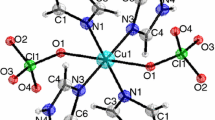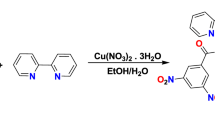Abstract
The urea complex of copper was synthesized and its structure was established by Fourier transform infrared (FTIR), electron spin resonance (ESR) and atomic absorption spectroscopy and elemental analysis to be Cu(urea)4Cl2. The thermal behaviour of this complex has been studied by thermogravimetry and differential thermal analysis and FTIR and ESR. Thermal analysis shows that the decomposition of the complex occurs in four stages of weight loss of different intermediates followed by three endothermal effects. The complex is thermally stable up to 428 K. The ESR and FTIR behaviour of the Cu(II)-urea complex during thermolysis was studied between 428 and 633 K. The experimental results suggest that in this temperature range the complex decomposition occurred forming thermodynamically stable regions of Cu(II) which are ferromagnetically coupled.
Zusammenfassung
Der Harnstoffkomplex von Kupfer wurde hergestellt, seine Zusammen-setzung ergab sich anhand von FTIR-, ESR- und Atomabsorptionsspektroskopie-Untersuchungen sowie Elementaranalyse mit der Formel Cu(Harnstoff)4Cl2.
Mittels TG, DTA, FTIR und ESR wurde auch das thermische Verhalten dieser Komplexe untersucht. Die Thermoanalyse zeigte, daß der Zersetzungsprozeß über verschiedene Zwischen-produkte in vier Stufen mit Massenverlust verläuft, gefolgt von insgesamt drei endothermen Effekten. Bis 428 K ist der Komplex thermisch stabil. Das ESR- und FTIR-Verhalten des Cu(II)-harnstoffkomplexes bei der Thermolyse wurde im Temperaturbereich 428–633 K untersucht. Die experimentellen Ergebnisse lassen darauf schließen, daß bei der Zersetzung des Komplexes in diesem Temperaturbereich thermodynamisch stabile Regionen von ferromagnetisch gekoppeltem Cu(II) gebildet werden.
Similar content being viewed by others
References
R. B. Penland, S. Mizushima, C. Curran and I. V. Quagliano, J. Am. Chem. Soc., 79 (1957) 1575.
M. Kishita, M. Inoue and M. Kubo, Inorg. Chem, 3 (1964) 237.
I. Bullock, J. Inorg. Nucl. Chem., 29 (1967) 257.
M. Vicens, M. Prats, J. J. Fiol and A. Terron, Inorg. Chim. Acta, 158 (1989) 59.
E. V. Miller, Chemistry of Plants, Reinhold, New York 1957.
P. R. Geissler and S. Rosenblatt, U.S. Pat. 3523018 (1970).
D. W. Smith, Inorg. Chem., 5 (1966) 2236.
A. Zamaguchi, R. B. Penland, S. Mizuschima and T. J. Jane, J. Am. Chem. Soc., 80 (1958) 527.
K. Nakamoto, Infrared Spectra of Inorganic and Coordination Compounds, Wiley, New York 1962.
H. J. Emeleus and A. G. Sharpe, Advances in Inorganic Chemistry and Radiochemistry, Academic Press, New York 1970.
P. C. Srivastava, B. N. Singh, S. K. Ghosh and N. C. Ganguly, J. Thermal Anal., 31 (1986) 1153.
Author information
Authors and Affiliations
Rights and permissions
About this article
Cite this article
Stojceva Radovanovic, B.C., Premovic, P.I. Thermal behaviour of Cu(II)-urea complex. Journal of Thermal Analysis 38, 715–719 (1992). https://doi.org/10.1007/BF01979401
Issue Date:
DOI: https://doi.org/10.1007/BF01979401




